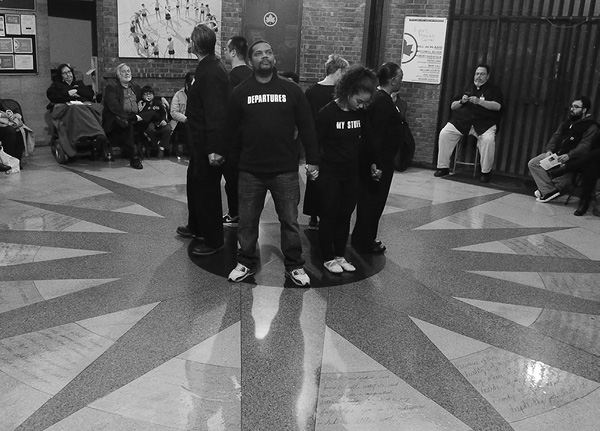
100 DAYS
first performed on December 7, 2014
Lyons Recreation Center Rotunda, Staten Island, NYC
performed once in 2014
MANDY MORRISON
Gabriella Dennery, Lori Greene, John Greene, Angelo Angelas, Terry Bennett, Rachel Carson, Lauren Denitzio
Staten Island, NY / Brooklyn, NY
172051970m172051970a172051970n172051970d172051970y172051970m172051970a172051970c172051970h172051970i172051970n172051970e172051970@172051970g172051970m172051970a172051970i172051970l172051970.172051970c172051970o172051970m
mandymachine.com
100 DAYS
MANDY MORRISON
“100 Days,” a spoken word and percussion performance, was initially conceived to capture the elliptical nature of daily thought and language, from a diverse range of perspectives. Ever since Roosevelt pioneered the 100 day concept taking office during the Great Depression, the phrase has been used by the U.S. media and scholars as a gauge of political success and activism. In the lives of ordinary people however, the number is often an arbitrary time frame that can demarcate incremental changes in the flow of daily life or a dramatic shift in one’s personal landscape through unforeseen events. With funding in 2014, from the New York State Council on the Arts, I planned this performance to include a small diverse group of local (Staten Island, NY) residents where I live, to be presented in a prominent community space. Select participants, including myself, were given a notebook with 100 pages in which to capture an observation for each day that passed over a three plus month period. The idea was that we would weave these divergent singular observations together and perform them as a group. Then, in late July, Eric Garner’s death occurred within blocks of the performance location which is a historic WPA, New York City Parks building.
This event and those that followed shifted the initial idea for the performance to that of experiences based on the participants’ personal lives. It was also becoming clear as my meetings with these individuals progressed that a different type of expression would be a more accessible way for them to put forward their thoughts to an audience. One of the participants had been on Welfare, one had been to prison and another had overcome addictions. They all had great story-telling abilities and had been through varying types of ordeals; as I got to know them, I felt that giving them the opportunity to share their stories in a public space should take precedence. This provided them the ability to ‘own’ their narratives with confidence. As I gave them ideas about how to present themselves, they became ‘dramatists’ in a manner that would have not have been possible initially. The first incarnation of the performance lasted 30 minutes, and was presented on December 7, 2014. Through interwoven narratives, this version illuminated a range of insights that took into account a specific timeframe (often tumultuous) from each participant’s life, as a point of reference. My dilemma as an artist is that while I often have difficulty with many aspects of social practice and socially engaged art, from an aesthetic perspective I am deeply appreciative of the need for arts culture to embrace differing voices and attitudes. This project is my way of entering into a dialogue within a contemporary art practice that attempts to address the problems and dissonances that face us as a people. I view this piece as an initial exploration in a process that has the potential to grow and expand into a larger form of performative expression.